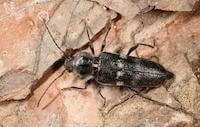WHAT DO old house borers LOOK LIKE

Old house borer, Hylotrupes bajulus (Coleoptera: Cerembycidae), adults are 5/8 to 1 inch long brownish to black beetles. While they belong to the longhorn beetle Cerembycidae family, old house borers are one of the species with antennae on the shorter side, extending only about 1/3 the length of the body. The distinguishing feature, if you find them in your home, is that they have two elevated black, shiny ‘knobs’ on the section behind the head. Faint patches of gray may also be present further back on the body. However, finding an adult beetle is relatively rare, with a few occasionally found near windows or other light sources when the adults emerge. But most of their life is spent inside the wood, as larvae, developing hidden within the wood. If extracted, they can be identified by the presence of three tiny black eyespots (ocelli) in a row on either side of the head (other less destructive species have no more than one eyespot). A hand lens or microscope is necessary to see this feature.
Fully mature larvae are stout (about the thickness of a pencil) and roughly an inch long. Their body is wrinkly in appearance between segments and tapers towards the head. Correct diagnosis of the old house borer is important since there are many other species associated with firewood, etc. that are less destructive. Definitive diagnosis may require confirmation by an entomologist or pest management professional.
Fully mature larvae are stout (about the thickness of a pencil) and roughly an inch long. Their body is wrinkly in appearance between segments and tapers towards the head. Correct diagnosis of the old house borer is important since there are many other species associated with firewood, etc. that are less destructive. Definitive diagnosis may require confirmation by an entomologist or pest management professional.